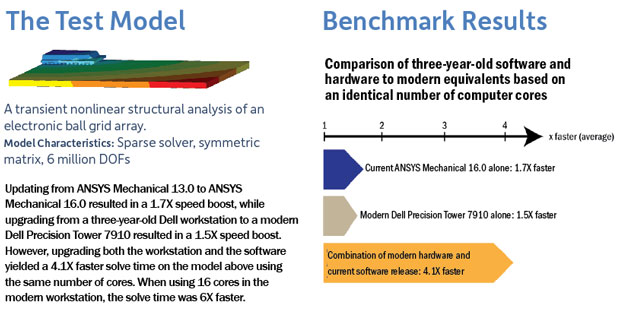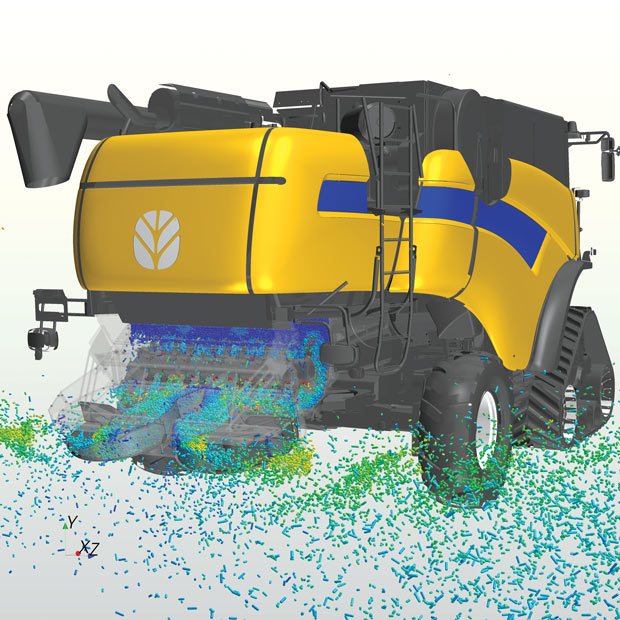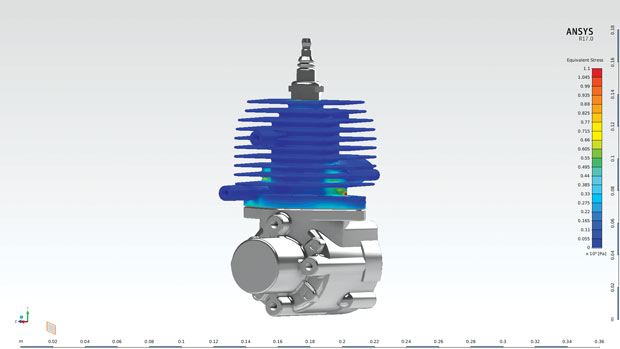
Flow results for an air-cooled engine modeled in ANSYS AIM. Image courtesy of ANSYS.
Latest News
March 1, 2016
 Illustration of the residue flow through the chopping and spreading mechanism of a New Holland combine harvester. The transient multiphysics simulation combines the DEM (discrete element method) and airflow capabilities of STAR-CCM+. Image courtesy of CNH Belgium N.V.
Illustration of the residue flow through the chopping and spreading mechanism of a New Holland combine harvester. The transient multiphysics simulation combines the DEM (discrete element method) and airflow capabilities of STAR-CCM+. Image courtesy of CNH Belgium N.V.Life is multiphysics. The coffee maker that uses heat, steam and pressure to produce a delicious shot of espresso, the laptop that uses airflow to cool the scorching heat from the overworked CPUs, the chair that uses load balancing to support the constantly shifting human muscles—many everyday products involve a mix of structural, mechanical, thermal, electrical and fluid behaviors. But in simulation, these phenomena are often represented as single-physics events to make them more manageable. To identify the ideal temperature range for coffee brewing, the designer may reduce the problem to thermal physics alone. And to improve the comfort and stability of a chair, they may focus on the stress on the chair’s surface area and leg-joints only.
But with some scenarios, the designers must take into account more than one type of physics. To study a radio frequency device’s performance, for example, the design team would have to consider interactions between its electromagnetic and thermal behaviors. Multiphysics simulation packages are tailor-made for such design studies. The ongoing challenge in this branch of simulation has always been the rarity of multi-domain experts.
Finding Multi-Domain Experts
Certain types of engineering software inherently promote multidisciplinary collaboration. Product lifecycle management (PLM) and product data management (PDM) systems are architected as digital repositories and communal dashboards for members of a project team to share ideas and track progress. CAD programs have historically been single-user software; however, some now have built-in tools to initiate collaborative design sessions. With such a feature, a mechanical engineer, electrical engineer and an industrial designer might come together to negotiate their respective preferences. In such multi-user environments, each user can take ownership of his or her functions without needing to learn the other domains.
Multiphysics software, despite its name, tends to be a single-user workspace to study coupled-physics phenomena. “We have multiphysics products, but they are typically for a single user,” says Dale Berry, Dassault Systèmes’ senior director of Technical Marketing for SIMULIA.
The burden on the multiphysics software user is thus a heavy one. “It’s pretty difficult to set up multiphysics in most current tools. It requires that you learn at least one different environment [outside your domain],” says Christine Wolfe, ANSYS’ lead product manager for Multiphysics. “If you’re a fluid engineer, you might also have to know—perhaps more than you’d like to—about finite element analysis (FEA). In addition, you need not only expertise in both disciplines but also the software.”
Bjorn Sjodin, COMSOL’s vice president of Product Management, similarly notes: “Even if you’re a simulation expert, you’re an expert in your own area, not in your colleague’s area. If your colleague hands you his simulation job, you still may not understand it or know how to set it up alongside yours.”
Template-Based Workflow for Non-Experts
Over the years, the simulation software industry came up with different ways to make multiphysics more accessible to a broader usage base, with varying degrees of success. Berry says the industry needs to rethink how the function is delivered.
“This is true for single-physics tools. It’s true for multiphysics. It has to be delivered in a way that’s accessible to design engineers,” he says. “We believe the key is a guided workflow. The software needs to have a framework that can build a guided workflow so designers can follow it step by step, without having to author the entire simulation. One benefit of this approach is, it standardizes the workflow for analyzing a valve, a pump and so on.”A guided workflow may be the outcome of the collaboration of various experts, each accounting for a type of physics involved in the analysis. But the user need not be an expert. With a basic understanding of the inner-workings of a valve or a pump, they could follow the sequence of inputs to complete the analysis. This is Dassault Systèmes’ vision with its all-encompassing 3DEXPERIENCE platform. “Inside 3DEXPERIENCE, you have the capability to author a guided workflow and deliver it to the designers,” Berry explains.
A similar approach is adopted by ANSYS in its product ANSYS AIM, described as an “integrated and comprehensive multiphysics simulation environment designed for all engineers.” Wolfe says, “With AIM, a single analyst, let’s say a fluid dynamics expert, can set up the mechanical portion of the multiphysics problem using the same tool, in the same environment, in the terms he or she is familiar with.” The intent, says Wolfe, is to use “flexible guided workflows” that allow design engineers—a much wider user pool than the experts—to set up and perform multiphysics simulation.
COMSOL, which explicitly markets its offerings as multiphysics, has adopted an app-driven approach. In late 2014, the company introduced the Application Builder in its flagship product COMSOL Multiphysics. With Application Builder, someone well versed in sophisticated simulation can publish a repeatable simulation job as an app. With far fewer input fields and variables, the published app could be used even by those with limited exposure to general-purpose simulation software.
“With an app, you can make the simulation complex in the background but keep [the interface] lean and simple in the front, so the same simulation can be passed along and shared with others—even with people who don’t regularly use simulation tools,” says Sjodin.
Code-Coupling or Co-Simulation
Some simulation software offers prebuilt environments to study commonly combined physics types together. For example, Dassault Systèmes SIMULIA’s Abaqus offers thermal-mechanical, thermal-electric and thermal-fluid-mechanical modules. COMSOL offers modules to study electrical, mechanical, fluid and chemical behaviors together. ADINA’s Multiphysics package comes with solvers for fluid-structure interactions, thermo-mechanical events, thermal-fluid-structural events and more.
Some simulation packages facilitate multiphysics studies via code-coupling or co-simulation. For instance, CD-adapco’s STAR-CCM+ allows users to combine its solvers with those from SIMULIA Abaqus. Commercial code-coupling is usually possible between products from simulation vendors that have a partnership and are willing to open up their APIs (application programming interfaces) to each other. With code-coupling, one package usually acts as the host, and the other as the plug-in.
“[Code-coupling] is pretty difficult to do,” Berry says. “The disciplines are different, the mechanics are different, and the things you need to know to use each code and be successful in that domain are different.” Consequently, such exercises are usually confined to the simulation experts, not generalists.
The Single-Physics Approach
With most simulation, reducing the scenario to a more manageable single-physics setup doesn’t compromise the quality of the study. “A lot of the simulations we do today are single physics,” ANSYS’ Wolfe estimates. “I’d venture to say 80% of the time, single physics solves the problem to the level of fidelity acceptable to the engineers.”
When engineers encounter problems that demand a multiphysics analysis, they may also break up the study into a series of single-physics studies. There’s no simple way to decide what truly requires multiphysics and which can be broken up and tackled one at a time. Consequently, what constitutes “multiphysics simulation” is sometimes up for debate.
David Vaughn, CD-adapco’s vice president of Worldwide Marketing, says the emphasis should be on multidisciplinary simulation—a category that encompasses multiphysics, in his view. “I think it is really important to provide a multiphysics platform with a focus on enabling multidisciplinary simulation and design exploration,” he says.
COMSOL’s Sjodin says: “Several experts may collaborate on a single 3D model to run multiphysics. But they may also run a sequence of simulation on different types of physics. So, perhaps one expert performs heat transfer, another does acoustic and another does fluid, and they pass the model back and forth. That can also be a form of multiphysics.”
The key “is to model the problem in multiphysics only when you need to. Otherwise, you waste resources. In some cases, you can feed the electromagnetic losses into your heat transfer simulation, then use the results as input to find out the structural deformation,” Wolfe says. “That’s a multiphysics study, even if you’re not modeling all the physics together. Only a small fraction of the simulation we do routinely is the kind where two physics are working so tightly together that they cannot be pulled apart.”
Multidisciplinary Collaboration
The current division of tools by specialty—one for FEA, another for structural analysis, another for thermal analysis and so on—seems to reflect the segmentation of engineering by discipline. But Vaughn argues the emergence of discipline-specific tools may have also contributed to the bifurcation of expertise.
“We believe we can bring engineers back together by offering a powerful tool,” says Vaughn. “The physics you have to model is, no doubt, complicated, but that’s the engineer’s job. They have to understand the physics. We can’t simplify the physics if we want the answers to be accurate. CD-adapco’s goal is to provide a tool that’s powerful, yet easy enough for engineers to use.”
In January, Siemens announced its plan to acquire CD-adapco. When the transaction is complete, CD-adapco will become part of the PLM software business of Siemens’ Digital Factory. The acquisition will bring together Siemens’ NX design software and CD-adapco’s simulation technology.
Because most multiphysics tools are currently set up as single-user environment, the collaboration occurs in the pre- and post-simulation discussions among the experts from different domains. “The multiphysics problem is what brings different experts together. The software can only facilitate the simulation,” says ANSYS’ Wolfe.
Dassault Systèmes’ Berry says: “Most companies have different expert groups—FEA group, CFD (computational fluid dynamics) group and structural group, for example. One group may look at external styling, another may examine engine and suspension, and another deals with drag, and another noise and vibration ... Each group uses a different tool and the opportunity for these groups to collaborate is present in multiphysics simulation. But the issue is more organizational, not technological.”
Multidisciplinary collaboration in multiphysics simulation is inevitable because it’s the most sensible way to study designs that can benefit from the inputs of several domain experts. There’s a limit to how much such complex studies can be simplified; the only way such a study can be performed by a non-expert is under the guidance of an expert—or several domain experts, as the case may be. Because it’s impractical to assemble a multidisciplinary team on the fly for every study, the next best alternative is to follow a guided workflow, a repeatable template collaboratively designed by multidisciplinary domain experts.
More Info
Subscribe to our FREE magazine, FREE email newsletters or both!
Latest News
About the Author
Kenneth Wong is Digital Engineering’s resident blogger and senior editor. Email him at [email protected] or share your thoughts on this article at digitaleng.news/facebook.
Follow DE







